

Những bài báo này tổng kết các nghiên cứu và dữ liệu trên trang này
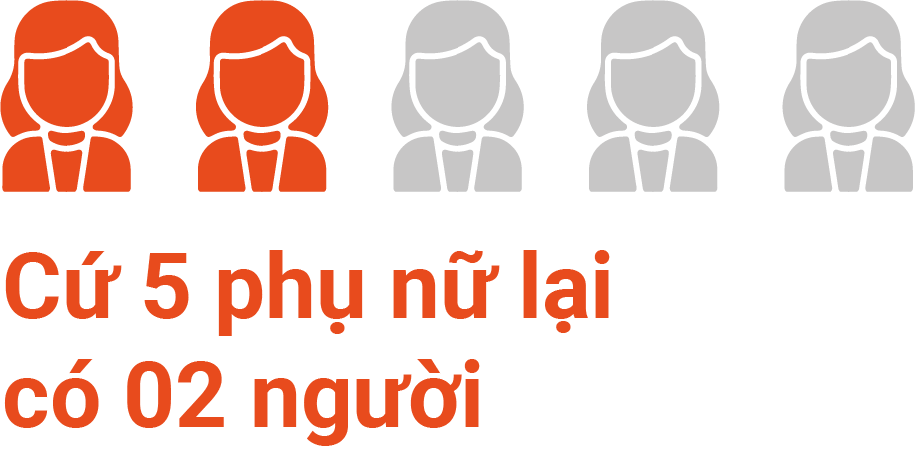
41% phụ nữ và cá nhân không theo chuẩn về giới bị quấy rối tình dục bằng lời nói hoặc hành động tại nơi công sở.
Trung bình, 30% trong số 2.000 người làm trong nghề truyền thông được khảo sát cho biết họ bị quấy rối tình dục bằng lời nói và hành động tại chỗ làm. Những người này trả lời khảo sát của chương trình Phụ nữ trong ngành Tin tức của Wan-IFRA trong khoảng thời gian từ tháng 110 năm 2020 đến tháng 9 năm 2021. Phân tích thêm yếu tố giới tính, tỷ lệ này lên tới trung bình 40% đối với phụ nữ và những người không theo chuẩn về giới. Trung bình, 12% số người nam được hỏi cho biết đã từng bị quấy rối tình dục.
Điều đáng lo ngại là, trung bình cứ 10 người được hỏi thì một người nói họ đã bị quấy rối 5 lần trở lên.

Trong mỗi 10 người được hỏi lại có một người nói họ từng bị quấy rối ít nhất 5 lần.
Một xu hướng đáng lo ngại khác trên tất cả 20 nước là việc họ không dám tố cáo về các vụ việc khi chúng xảy ra. Trung bình, chỉ có 1 trong 5 vụ quấy rối tình dục được báo cáo một cách chính thức hoặc không chính thức trong các cơ quan truyền thông.
Cũng nhất quán trên tất cả 5 khu vực là việc các cơ quan thiếu phản ứng khi nhận được khiếu nại. Trung bình, các cơ quan chỉ hành động trong hơn một nửa số trường hợp được báo cáo. Và khi hành động, phản ứng phổ biến nhất là "cảnh cáo thủ phạm".
Thủ phạm thường xuyên được trích dẫn nhất về quấy rối tình dục là các đồng nghiệp (39,3%), tiếp theo là quản lý cao hơn (18,9%) hoặc người giám sát trực tiếp (19%).
Quấy rối bằng lời nói
Tỷ lệ báo cáo theo khu vực cũng cho thấy một số khác biệt. Ở Trung Mỹ, mức độ báo cáo cao nhất, 26%, và khu vực Ả Rập có mức thấp nhất, 15%.
Khi được hỏi điều gì cản trở việc báo cáo, phản ứng áp đảo là việc thiếu hiểu biết hoặc nhận thức về những phương thức báo cáo sự việc và việc sợ hậu quả không mong đợi nếu báo cáo sự việc. Chưa đầy 11% số người được hỏi nói rằng họ biết liệu các cơ quan họ có có chính sách về vấn đề quấy rối tình dục hay không.
Trong suốt thời gian nghiên cứu dài 12 tháng, chương trình Phụ nữ trong Tin tức của WAN-IFRA đã thực hiện các cuộc phỏng vấn sâu với 85 giám đốc điều hành truyền thông cao cấp từ 18 trong 20 quốc gia mục tiêu. Một xu hướng nhất quán được xác định là sự xa rời giữa nhận thức của họ và thực tế, xét về việc hiểu đúng quy mô của vấn đề bên trong cơ quan truyền thông của họ hay trong ngành ở thị trường cụ thể của họ.
43,5% quản lý cấp cao trong ngành báo chí truyền thông được phỏng vấn báo cáo rằng chính họ từng bị quấy rối tình dục. Tuy nhiên, trong cùng một nhóm này, chỉ có 27% cảm thấy quấy rối tình dục vẫn là một vấn đề trong ngành. Vấn đề này càng trầm trọng hơn với sự thiếu hiểu biết về chính sách quấy rối tình dục của chính họ: Chỉ hơn 1 trong mỗi 10 người được phỏng vấn biết các tổ chức của họ có chính sách về quấy rối tình dục hay không.
Sự thiếu nhận thức về phạm vi vấn đề này có thể là do ít người báo cáo - trong đó đây là biểu hiện của tình trạng thiếu rõ ràng về cách báo cáo một vụ việc khi nó phát sinh, như đã nêu ở trên.
Các cơ quan truyền thông có thể thực hiện những biện pháp rõ ràng giúp trang bị cho đội ngũ quản lý của họ các công cụ phù hợp để giải quyết và giảm thiểu nạn quấy rối tình dục tại công sở. Một chính sách được xác định rõ ràng, dễ tiếp cận về nạn quấy rối tình dục là rất cần thiết. Thêm nữa, cần đào tạo các lãnh đạo quản lý về cách xử lý các vụ việc một cách nghiêm túc và mang tính tôn trọng. Bước quan trọng đầu tiên có thể giúp các nhà quản lý truyền thông hiểu rõ hơn về mức độ nghiêm trọng của vấn đề là thực hiện một cuộc khảo sát ẩn danh nội bộ.
Những phát hiện từ nghiên cứu toàn cầu này cho thấy nạn quấy rối tình dục vẫn là một vấn đề phổ biến trong ngành truyền thông.
Hãy tìm hiểu thêm về những gì cần làm để giải quyết nạn quấy rối tình dục trong cơ quan truyền thông của bạn.
African media has a sexual harassment problem. But many cases of physical and verbal sexual harassment go unreported because of fear of further victimisation and a lack of confidence in management systems and interventions. When action is taken, results are often underwhelming.
WIN’s latest research, the first phase of a multi-region study, set out to collect credible information about the scale of harassment in news outlets in Africa and to establish what was being done to provide safer newsrooms.
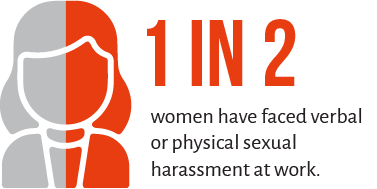
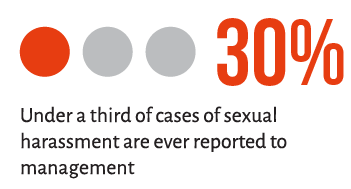
575 survey respondents, from eight countries, namely Kenya, Malawi, Zambia, Zimbabwe, Botswana, Tanzania, Uganda and Rwanda, responded to questions on sexual harassment at work - verbal and/or physical. It found:
Fear prevented many from filing formal complaints. These were the common concerns:
The absence of and lack of awareness of reporting mechanisms also explained inaction.
Almost half, 46.7%, of those surveyed said their organisation had no sexual harassment policy, 35.9% were unaware of what was in the policy and just 17.4% were aware of its contents.
Of the 32 managers interviewed 68.7% said their organisation had a sexual harassment policy - 46.7% had been trained on it.
Perhaps the biggest impedance in reporting is that the perpetrators are often managers or supervisors - people with responsibility and power. Survey respondents identified their harassers as fellow employees (in 38.8% of cases) but 22.1% of the time they were direct supervisors and in 19.4% of cases, members of higher management.
When action was taken in 57% of cases reported, the most common organisation response was to warn the perpetrator (46.2%). 14.5% of responses said training was offered and 9.7% had the case dismissed.
“The research highlights a lack of trust in the organisation, or sometimes complete failure of management and systems, to deal effectively with sexual harassment,” said Melanie Walker, WAN-IFRA’s Executive Director, Media Development and Women in News.
“This matters because the less confidence there is in an organisation’s ability to address the problem, fewer people will see value in calling it out, and so the cycle will perpetuate.” There are solutions, however, beginning with owners and managers acknowledging the problem exists and then committing to ensuring a safer working space, not just for women, but for all staff. It is vitally important to change the culture of silence around harassment. And this culture change can only come from the very top.”
In supplementary interviews with 32 media managers, we found
“There are divergent views on the scale of sexual harassment between the survey respondents and managers we interviewed. There is no simple explanation for this - but what is common is that both staff and managers have had first-hand experience of sexual harassment, and in most cases chose not to report it. This suggests fear of victimisation runs alongside a lack of confidence in management systems and any apparent remedies,” said Walker.
Women in News, which offers expert input on how to manage sexual harassment, is starting to see little victories among those media organisations that have begun to actively manage the problem - starting with adopting policies and procedures that the staff can support. “But the numbers are very small and we have a very long way to go before staff are convinced and comfortable that if there are incidents of harassment, they can report them, and action will be taken, without further victimisation,” said Jane Godia, Africa Director of WIN and an expert and trainer managing sexual harassment.
“We are still working on changing perceptions and debunking cultural beliefs that perpetuate sexual harassment,” said Godia.
Nghiên cứu đã đưa ra bằng chứng cho thấy cơ quan báo chí cần nhận thức được mức độ của vấn đề quấy rối tình dục và cần xây dựng kế hoach, bước đi để tạo dựng môi trường làm việc an toàn hơn.
Bà Walker cho rằng “tất cả bắt đầu từ việc trao đổi đâu là hành vi chấp nhận được và không chấp nhận được trong cơ quan báo chí của mình – nên cởi mở về vấn đề quấy rối tình dục – chia sẻ cách hiểu, hành vi nào không được chấp nhận, và giúp mọi người hiểu mỗi người đều có quyền được đối xử bình đẳng. Việc xây dựng và đề ra chính sách là chưa đủ; nhân viên và cán bộ quản lý cần được đào tạo về cơ chế tố cáo và xử lý tố cáo. Mọi người cần hiểu rõ hậu quả của hành vi quấy rối tình dục. Chúng ta nên chủ động ngăn chặn, phòng ngừa thay vì phải rơi vào tình trạng xử lý khủng hoảng khi xảy ra vụ việc quấy rối.”
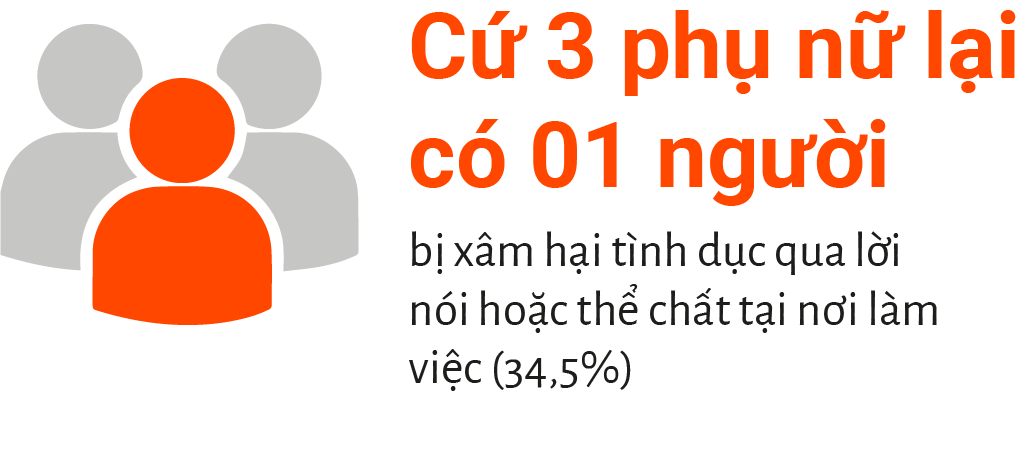
Công tác quản lý các cơ quan báo chí chủ yếu được thực hiện trên cơ sở niềm tin cho rằng người lao động biết cách cư xử có chừng mực tại nơi làm việc. Tuy nhiên, thực tế cho thấy quấy rối tình dục vẫn là một vấn nạn khá phổ biến – đặc biệt đới với phụ nữ - và những hành vi này thường bị bỏ qua, không bị tố cáo. Việc chỉ có một trong số sáu trường hợp bị quấy rối tố cáo lên cấp trên cho thấy văn hóa im lặng và sợ hãi vẫn tiếp tục tồn tại.
Tình trạng này càng phức tạp hơn khi nhận thức về quy mô của vấn đề có sự khác biệt giữa cán bộ quản lý và người lao động. Mặc dù cứ ba phụ nữ lại có một người bị quấy rối tình dục tại nơi làm việc, 84,1% cán bộ quản lý tham gia phỏng vấn cho rằng quấy rối tình dục không phải là vấn đề của lĩnh vực báo chí. Đây là khoảng cách góc nhìn rất lớn.
Những kết quả này là một phần trong khuôn khổ một nghiên cứu đa vùng nhằm thu thập bằng chứng về quy mô của tình trạng quấy rối tình dục. Toàn bộ nghiên cứu giúp chúng ta hiểu rõ hơn sự tương đồng và khác biệt trong lĩnh vực báo chí ở khu vực Nam bán cầu.

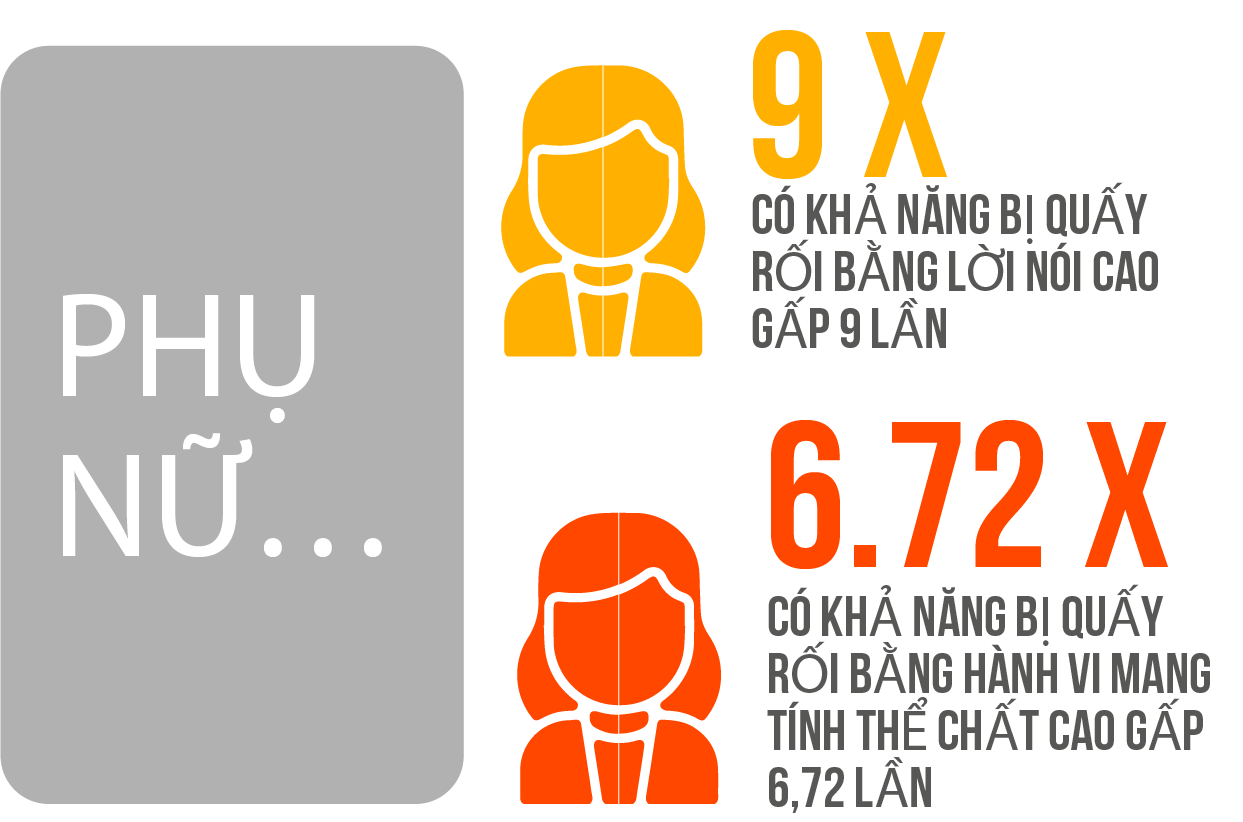
494 người tham gia khảo sát từ năm quốc gia gồm Indonesia, Myanmar, Malaysia, Philipin, và Việt Nam đã trả lời những câu hỏi về quấy rối tình dục tại nơi làm việc – qua lời nói và/hoặc thể chất. Kết quả cho thấy:
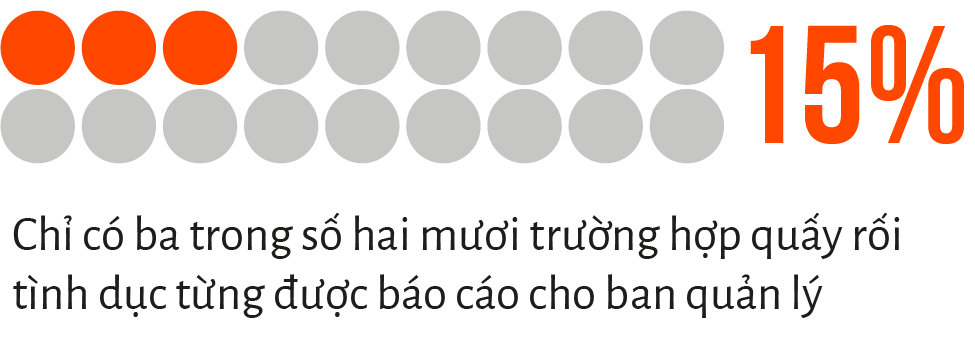
Tình trạng không tố cáo đầy đủ các trường hợp quấy rối tình dục đã trở thành một vấn nạn đối với cả người lao động và cán bộ quản lý. Trong khi chỉ có 15% người tham gia khảo sát tố cáo hành vi này thì tỷ lệ này ở cán bộ quản lý chỉ là 33% (trong số sáu cán bộ quản lý bị quấy rối tình dục trong tổng số 19 người tham gia, chỉ có hai người tố cáo hành vi này).
Tất nhiên chúng ta đều mong muốn phải có hành động xử lý hành vi này nhưng chỉ 42% cán bộ quản lý cho biết họ biết về chính sách chống quấy rối tình dục của đơn vị mình và đây là kết quả không bất ngờ.
Qua các cuộc phỏng vấn bổ sung với 20 cán bộ quản lý, chúng tôi thấy
Đẩy mạnh tuyên truyền về các chính sách chống quấy rối tình dục và cách triển khai thực hiện là bước đầu tiên góp phần đẩy mạnh các hành động xử lý hành vi này. Với thực trạng chỉ 3 trong số 8 cán bộ quản lý biết về các chính sách này được trực tiếp tham gia đào tạo tập huấn, đây có thể là bước đi tạo ra tác động to lớn. Ý tưởng này được hơn một nửa số cán bộ quản lý ủng hộ và đề nghị tăng cường đào tạo tập huấn về các yếu tố cấu thành quấy rối tình dục và cách xử lý tình huống.
Có lẽ rào cản lớn nhất cản trở việc tố cáo hành vi này là thủ phạm thường là cán bộ quản lý hoặc giám sát – những người có trách nhiệm và quyền lực. Những người tham gia khảo sát cho biết người quấy rối họ là đồng nghiệp (34.6% số vụ) nhưng 18.2% là cán bộ cấp trên và 13.4% số vụ là cán bộ giám sát trực tiếp.
Theo bà Melanie Walker. Giám đốc Phát triển Truyền thông và Chương trình Phụ nữ trong lĩnh vực Báo chí của WAN-IFRA, “Nghiên cứu cho thấy sự bất đồng nhận thức về tình trạng quấy rối tình dục trong lĩnh vực báo chí. 73,6% cán bộ quản lý cho rằng đây không phải là vấn đề của ngành và thêm khoảng 10,5% cho rằng đây đã là câu chuyện quá khứ. Điều này trái ngược hoàn toàn với thực trạng cứ ba phụ nữ lại có hơn một người phải đối mặt với hành vi quấy rối ở mức độ nhất định tại nơi làm việc – và con số này là 4% ở nam giới.”
“Đây thực sự là vấn đề khó khăn vì bước đầu tiên trong việc xử lý quấy rối tình dục là phải hiểu rõ bản chất của quấy rối tình dục và thừa nhận nó thực sự tồn tại. Chúng tôi rất vui khi thấy cán bộ quản lý đều ủng hộ quan điểm cho rằng cần tăng cường đào tạo tập huấn để nâng cao hiểu biết về quấy rối tình dục và cách xử lý. Chúng tôi lạc quan cho rằng việc tiếp tục hợp tác với các cơ quan báo chí trong khu vực sẽ giúp tháo gỡ những bất đồng và nâng cao hiểu biết lẫn nhau.”
Chương trình Phụ nữ trong lĩnh vực Báo chí thời gian qua đã mở rộng hoạt động tới khu vực Đông Nam Á và tham gia hỗ trợ chuyên môn về cách xử lý vấn đề quấy rối tình dục. Thông qua việc làm việc trực tiếp với các cơ quan báo chí và cá nhân qua chương trình Nâng cao Năng lực Lãnh đạo, cán bộ quản lý và nhân viên có thể được trang bị kiến thức về chính sách và quy trình chủ động xử lý vấn đề này. Nhưng có lẽ quan trọng hơn cả, mỗi cá nhân được hỗ trợ nâng cao hiểu biết về quyền của mình và cơ quan báo chí hiểu rõ trách nhiệm của đơn vị. Theo nhận định của bà Khin Thandar Htay, Giám đốc khu vực Đông Nam Á của WIN, “con đường dài phía trước bắt đầu từ việc nâng cao hiểu biết về quấy rối tình dục và lý do nó vẫn tồn tại. Việc xóa bỏ quấy rối tình dục ra khỏi mỗi cơ quan báo chí sẽ tạo ra môi trường làm việc an toàn hơn và nhờ đó phụ nữ có thể thăng tiến dễ dàng hơn.”
Nghiên cứu đã đưa ra bằng chứng cho thấy cơ quan báo chí cần nhận thức được mức độ của vấn đề quấy rối tình dục và cần xây dựng kế hoach, bước đi để tạo dựng môi trường làm việc an toàn hơn.
Bà Walker cho rằng “tất cả bắt đầu từ việc trao đổi đâu là hành vi chấp nhận được và không chấp nhận được trong cơ quan báo chí của mình – nên cởi mở về vấn đề quấy rối tình dục – chia sẻ cách hiểu, hành vi nào không được chấp nhận, và giúp mọi người hiểu mỗi người đều có quyền được đối xử bình đẳng. Việc xây dựng và đề ra chính sách là chưa đủ; nhân viên và cán bộ quản lý cần được đào tạo về cơ chế tố cáo và xử lý tố cáo. Mọi người cần hiểu rõ hậu quả của hành vi quấy rối tình dục. Chúng ta nên chủ động ngăn chặn, phòng ngừa thay vì phải rơi vào tình trạng xử lý khủng hoảng khi xảy ra vụ việc quấy rối.”
Women in Russian media are four times more likely to experience sexual harassment than men. A report on the scale of sexual harassment in Russia has shown how pervasive it is, yet just one-quarter of cases are ever reported to the management.
The research, commissioned by the World Association of News Publishers’ (WAN-IFRA) Women in News programme found that of those women media professionals who experienced harassment, 31% experienced verbal harassment and 14% experienced physical attacks. 22% of media professionals (men, women and gender non conforming individuals) report to experiencing harassment or some kind.
The survey, which is part of a multi-region study undertaken in partnership with City, University of London, set out to collect data on the scale of sexual harassment in media organisations in Russia, and to establish what was being done to provide safer newsrooms. 176 media professionals were surveyed. Supplementary in-depth interviews were conducted with 16 media executives.
WIN has been engaging with journalists and media managers on sexual harassment for more than 10 years. In that time, we have collected plenty of anecdotal evidence of sexual harassment. But this is the first time we have been able to draw on large-scale data to support the belief that it is prevalent everywhere and is a significant impediment to a healthy media industry, regardless of country or cultural context.
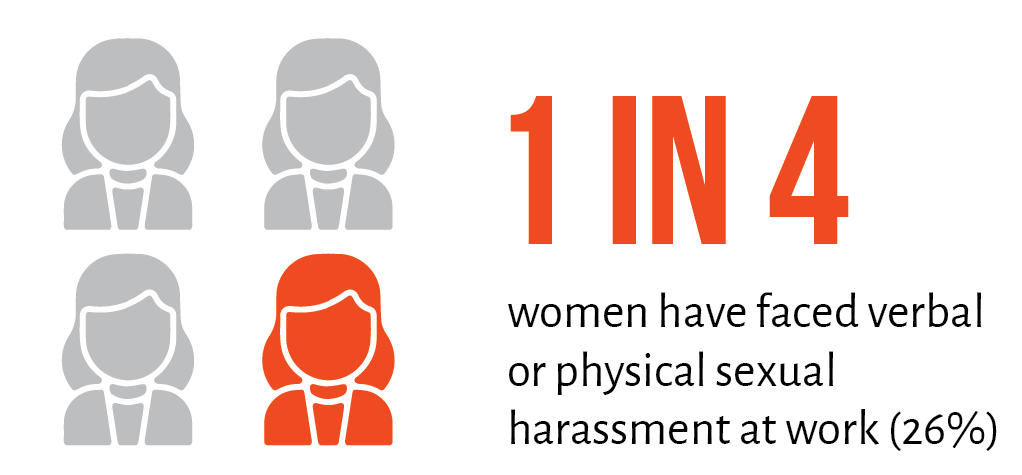
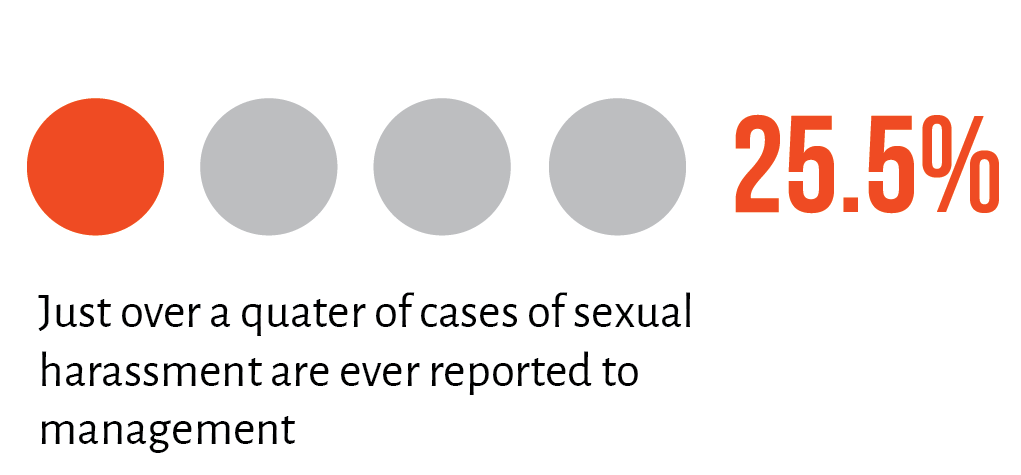
While sexual harassment in newsrooms for women is much more prevalent, men have not been spared.- though they are four times less likely to experience it than women, of those surveyed, 12 per cent had experienced verbal sexual harassment. None of them had been physically harassed.
Overall, just under one in four respondents (23.4%) had witnessed at least one incident of sexual harassment at work – but reporting of these cases remained low at 25.5 per cent.
The survey found:
In Russia, an average of 25.5% of cases of sexual harassment were reported to the management at media organisations. While 62% of these result in action by management, the low reporting rate means the majority of perpetrators are never disciplined and survivors never receive support.
Fear - fear of losing a job, negative repercussions, retaliation or being negatively labelled - was the prevailing reason for not reporting. Combined, it represents 39.7% of responses.
The top individual reasons \were no known reporting mechanisms (17.1%) and not thinking it was a big deal (15.3%).
Further, when respondents did report sexual harassment, news organisations took action less than two-thirds (62%) of the time. The most common responses from organisations when they took action were:
Direct action against the perpetrator almost never occurred. Firing, transfer, and suspension of the perpetrator were each only reported one time. The most common source of sexual harassment were fellow employees, followed by management (34.2%, combined total of direct supervisor and higher management).
“Understanding abuse of power is crucial to understanding who sexual harassment happens to and why. It tends to have nothing to do with sincere sexual or social interest. Instead, it happens where there are unequal relationships, for example between a superior and their subordinate, or between an older employee and a younger employee,” Melanie Walker, Executive Director, WAN-IFRA Women in News.
When asked if sexual harassment is an issue in the news industry, 15 news executives responded no, and one said maybe. This is in stark contrast to the 35% of women who reported experiencing verbal sexual harassment and 17% who reported experiencing physical harassment. This gap may also explain why 35% of responses said that organisational barriers, such as no reporting mechanism, not knowing how to report or thinking they wouldn’t be believed, were why they didn’t report the harassment they experienced.
To understand management perspectives on the prevalence of sexual harassment, WIN interviewed 16 managers and executives: 11 were women and five were men.
Three women stated they had experienced sexual harassment, but none had reported this.
The consensus between the news executives was that sexual harassment may occur in Russia in general, but it was an issue to be reported on, not one that was experienced by news personnel.
“I don’t think sexual harassment is a problem. If an issue arises, staff know how to defend themselves. Moreover, I have women who will fight back against anyone if this happens. We are all in a transparent environment; we see each other,” said one editor-in-chief.
“It is difficult for me to answer this question unequivocally. The honest answer: more likely yes than no,” said a deputy editor-in-chief.
When asked if any of their employees had reported cases of sexual harassment to them, three of the 16 executives answered yes, and their response was to discuss the incident with those concerned.
On reduced complaints, one CEO said: “Since the beginning of the #MeToo movement, many men have been rethinking their actions. Nonetheless, I remain concerned about sexual harassment and realise we can do better.”
Interestingly, when we asked respondents if their work environment was supportive, for women, 76.2% somewhat to strongly agreed they could openly talk to their supervisor, 88.1% somewhat to strongly agreed they felt listened to at work, and 88.8% somewhat to strongly agreed they felt safe in their newsroom. This seems to be in contrast to their experiences.
In response to a question on whether or not the executives believed their employees felt comfortable reporting sexual harassment incidences to their news organisations, 12 said yes.
“I’m sure about the women. They certainly would tell. They always talk about their problems: from health problems to personal dramas and breakups. With men, I’m not so sure. A man should deal with his problems on his own - this is the Russian mentality. You’re not a man if you show your weakness or ask for help,” said one general director.
Executives’ beliefs that sexual harassment is a non-issue in their workplace contrast with the respondents’ views, where one in four women have experienced either unwanted verbal or physical harassment at work.
Respondents said the perpetrator was most likely a fellow employee but that they do receive significant unwanted attention from people in power in the organisation - namely supervisors and executives.
The overarching stand from managers that there was no need for explicit sexual harassment policies and procedures may explain why reporting is low. A common reason for not reporting was dismissing the event as no big deal. However, one respondent pointed to a feeling of shame around verbal harassment, in line with cultural norms that silence victims.
Additionally, when asked if they knew if their organisations had an anti-sexual harassment policy, of the 16 news executives, only two were aware of such a document. And when asked to provide suggestions for eliminating sexual harassment in the news industry, they focused on the importance of communication in creating a comfortable atmosphere. Most executives believe this exists in their workplace, therefore, sexual harassment is not a significant issue.
The research findings go beyond anecdotes and demonstrate that sexual harassment does exist in Russian media organisations. The managers’ confidence that their workplaces, with their open communication policies, are not hotbeds for harassment, feeds into the notion that sexual harassment is a problem of the past and continues to create unsafe work environments for all of their staff.
The first step is making sure executives really understand what constitutes sexual harassment and just how pervasive it is. Only from there can policies be enacted and working cultures change to stamp out this scourge from all media organisations and, ultimately, all workplaces in general.
“The study showed that many publishers try to create an open, friendly atmosphere in their newsrooms and sincerely believe that this protects against harassment. But incidents can happen in any team and in any organization. It is important to know what to do and how to proceed in this case in order to protect people. You should have the reporting mechanisms, the investigative procedures and rules, the understanding of actions in response. The study revealed they do not exist, or employees do not know about them. Together with WIN WAN-IFRA, ANRI-MEDIA is taking very first steps in this direction to help media outlets create a safe business environment. For example, we adopted a WIN Guide on countering harassment in the media with practical templates and recommendations." Anna Koshman, ANRI-Media
Although 85% of sexual harassment incidents go unreported in the Arab media industry - management is starting to take some concrete actions to break the circle of silence.
526 media professionals participated in a survey from February to April 2021 distributed in Egypt, Jordan, Lebanon, and Palestine as part of a multi-region study to provide evidence of sexual harassment in the media industry. Just over half of the participants were women (54%).
On average one in three women have faced some form of sexual harassment at work (35%). More than 50% have experienced verbal harassment. Yet only 12% of incidents are reported. Men are more likely to see action taken on their behalf. On average, 50% of cases reported by men received action from their organisation, compared to 41% for women.
In addition, when asked if their organisation has an anti-sexual harassment policy, only 7% said there is one in place and they are aware of it.


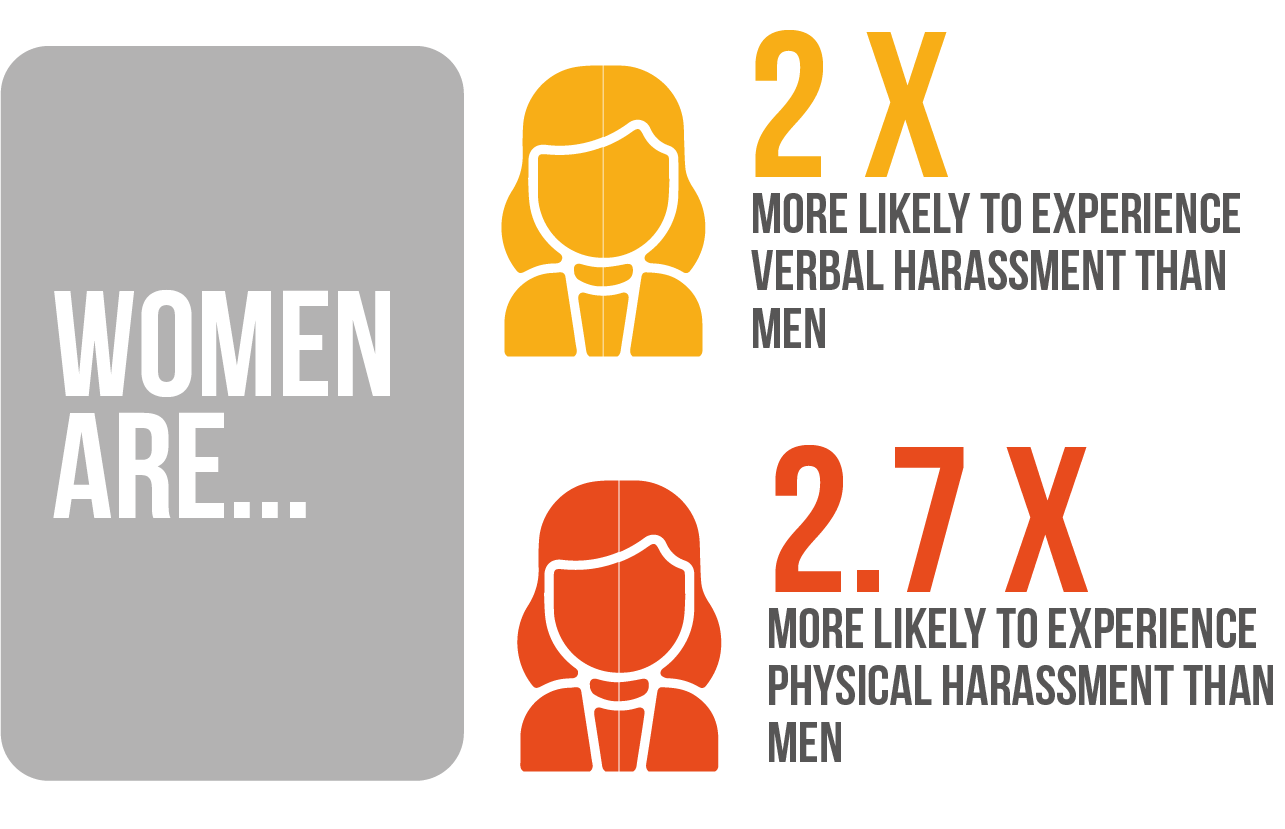
When respondents were asked questions on types of sexual harassment they faced at work women were almost twice as likely to experience verbal harassment compared to men, 52% and 24% respectively. The gap expands more when comparing data on physical harassment (19% and 7%).
Though a small sample size, of respondents who did not specify their gender in the study (almost 15% of the total responses), 29% experienced verbal sexual harassment, 14% experienced physical sexual harassment.
Furthermore, one in two participants stated that they have witnessed sexual harassment - 13.5% five or more times.
The results of this study reveals that sexual harassment is still existing, profoundly, in the media sector, which stresses the need and importance of taking actions to deal with it in an effective way.

Underreporting of sexual harassment is endemic. Providing safe space to talk freely about those cases, and guaranteeing confidentiality and protection are needed, in addition to raising the awareness of speaking up, showing the added value of protecting others from witnessing such recurrent situations.
Yet, of those reported cases, news organisations took actions 46% of the time, a step forward to activate the organisational role in ensuring safety and security of employees at the work environment.
The top reasons listed for not reporting were no known reporting mechanism available (17.3%), not having evidence (13.8%), and not wanting to be negatively labelled (12.8%). The most common responses of organisations when they took action was firing the accused (24.5%), and dismissing with no further action (20.5%).
The reasons for not reporting are brilliantly revealing the way to increase reporting rates: adapt a clear and comprehensive mechanism that applies fair rules, which help change the organisational culture to embracing openness and transparency instead of shame and blame paradox.
AR respondents revealed that the most common source of sexual harassment was a fellow employee (42.9%), followed by direct supervisor (22.2%), higher management (14.6%), other (10.7%), and news source (9.5%).
Numbers show that most sexual harassment incidents happen inside the media organisations at work, whether by the same level of management employees or higher. Firm procedures to help all staff members enjoy a safe workplace is a must.
Nghiên cứu đã đưa ra bằng chứng cho thấy cơ quan báo chí cần nhận thức được mức độ của vấn đề quấy rối tình dục và cần xây dựng kế hoach, bước đi để tạo dựng môi trường làm việc an toàn hơn.
“It all starts with a conversation on what is and isn’t acceptable behaviour in your media organisation. - being explicit about sexual harassment - sharing definitions, what behaviours are unacceptable, and communicating the right for every employee to be treated equally. It is not enough to have a policy; staff and managers must be trained on what the procedures are for making and managing a complaint. Everyone should be clear about the consequences of sexual harassment. It is far better to be proactive and prepared than pushed into a crisis management position when a case emerges,” said Melanie Walker, Executive Director, WAN-IFRA Women in News.
The media industry in Nicaragua and El Salvador has a sexual harassment problem. On average, 74% of women in media have experienced verbal sexual harassment. More than 40% have experienced physical harassment. These are amongst the highest rates of sexual harassment of all countries surveyed in the 20-country study, completed in November 2021.
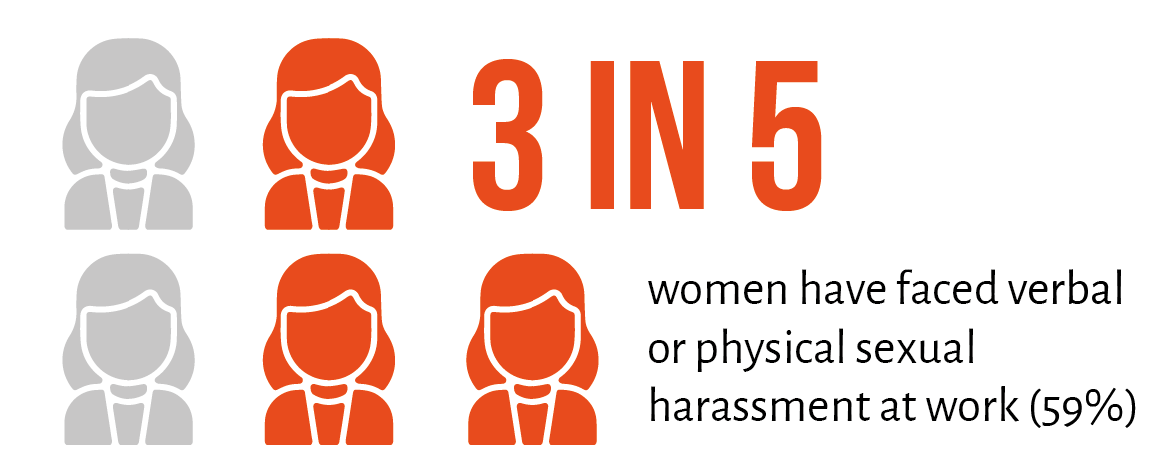
234 media professionals in Nicaragua and El Salvador participated in a survey, in addition to 18 media executives who provided supplementary in-depth interviews to understand the extent of sexual harassment in the industry.
The data shows that women are disproportionately affected, experiencing verbal and physical sexual harassment at least four times more than men. Moreover, women experience sexual harassment far more often than men, with almost half of the women surveyed indicating they have experienced verbal sexual harassment five times or more, compared to 5.8% of men.

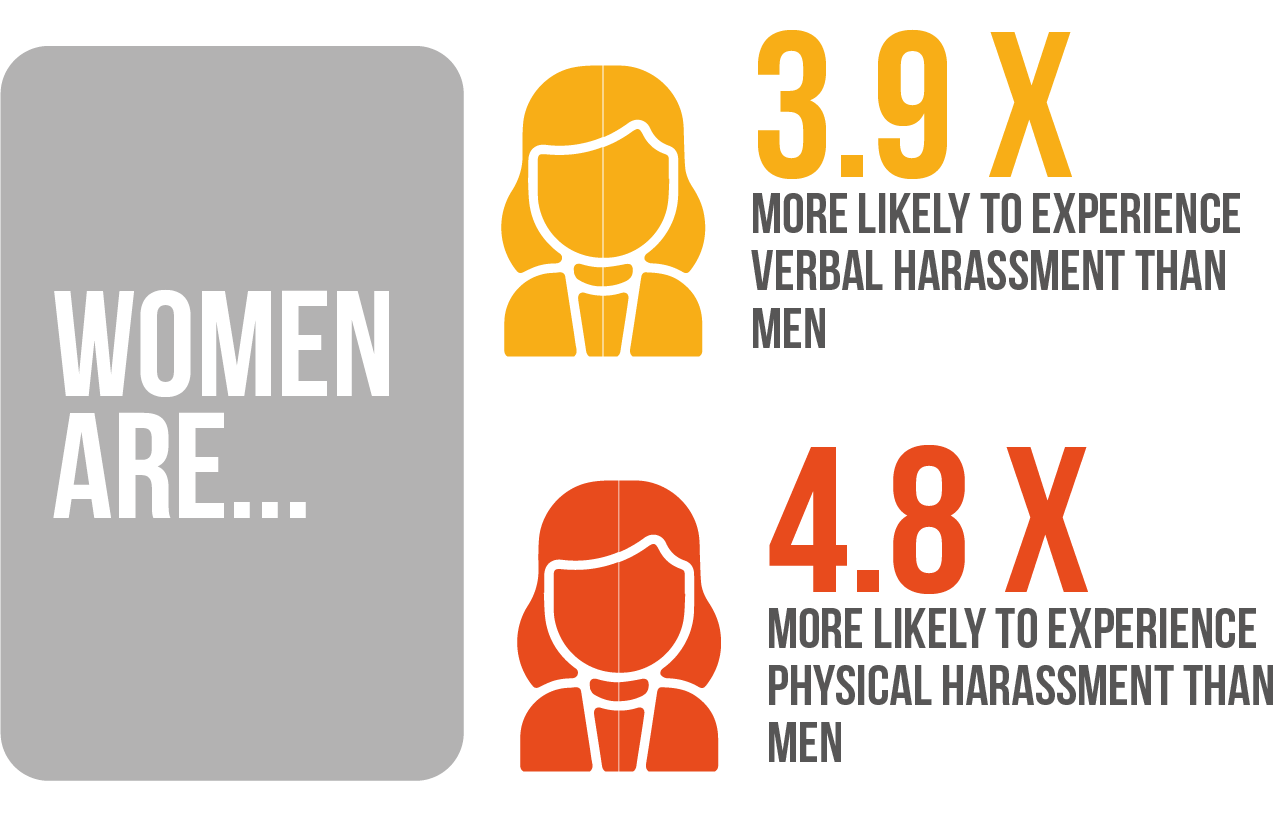
Given these high figures, it is not surprising that almost 60% of the participants had witnessed at least one incident of sexual harassment with 21% stating they had seen five or more. The most common source of sexual harassment was a fellow employee (42%), followed by higher management (25%).
Despite the high prevalence of sexual harassment, on average only one in every four cases was reported. Action was taken in just under half (46%) of incidents that were reported. Responses from both survey participants and news executives indicated the lack of a known sexual harassment policy. This is reflected by the survey respondents, where the top reasons for not reporting cited were ‘no known reporting mechanism available’ and ‘not knowing how to report’. The other reasons for not reporting were ‘fear of perpetrator retaliation’ or ‘fear of a negative impact in their professional career’.

Interestingly, when the interviewed news executives were asked if sexual harassment was a problem, the majority said yes, but not in their newsroom. More than half of the news executives interviewed stated that their newsrooms were exceptions to the overall atmosphere in the news industry, were sexual harassment was common.
The most common responses of organisations when they took action was warning the perpetrator (56.4%), offering emotional support for the victim (16%), and the victim being transferred to another department (10.3%).
Media organisations in Central America need to recognise the extent of sexual harassment and put in mechanisms to provide a safer working environment. The research shows that sexual harassment is a significant problem. The lack of policies aimed at preventing sexual harassment and at addressing it properly when it occurs, along with the common fear to report results in high levels of sexual harassment in the Central American media industry that go largely unchecked.